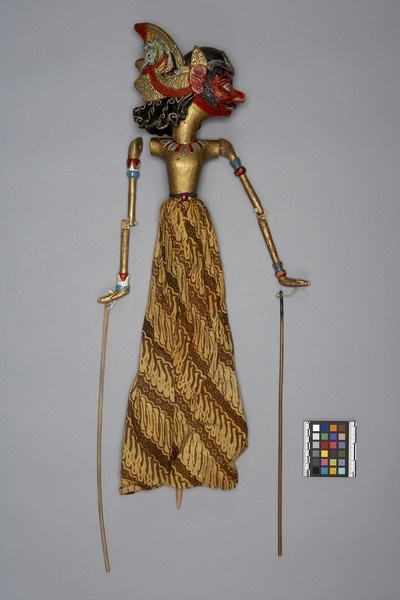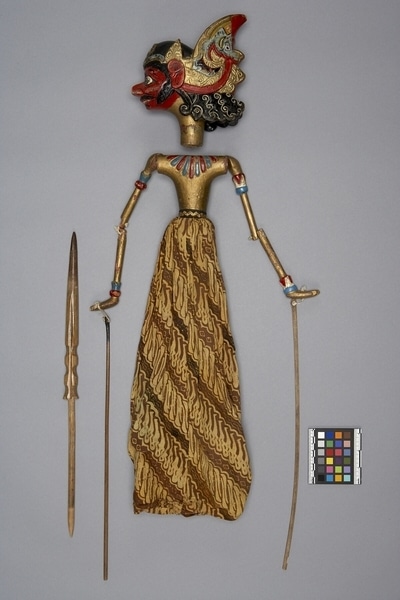Rod Puppet Item Number: Ib337 a-d from the MOA: University of British Columbia


Description
Three-dimensional male humanoid puppet: large head (part b) fits into body with skirt (part a) from which the figure's right arm (part d) has become detached, and a control rod (part c) with six notches on the handle and a long shaft that passes through the body and fits into the neck of the figure's head. The body has jointed arms, each with a long controlling rod attached. Red face, bulging eyes with blue irises, black moustache, short beard, large blunt nose, upper teeth visible with two very small fangs. Black cap with blue and gold looped ornament; red and blue sekar kluwih headdress with gold sumping, blue and red Garuda Mungkur with short gold tongue, several gold and red badong. Black curly hair decorated with white, showing below headdress. Gold neck. Head detachable and joined to body by controlling rod which extends through body, marked with finger grips. Gold slender torso. Gold arms; red and blue necklace; arm on left articulated at elbow by string but unattached at shoulder and has red, white, and blue upper arm and wrist ornaments. Arm on right articulated at shoulder and elbow by string and has blue and red upper arm and wrist ornaments. Hands with fingers straight and at right angles to arms. Yellow and brown batik skirt.
History Of Use
Javanese puppetry as an art form probably developed by the 11th century. The three-dimensional wooden wayang golek puppets of western Java appeared during the 16th century. Originally the plays depicted Javanese mythology, but after the Indian conquest of Java the Hindu epics, Ramayana and Mahabharata, were incorporated into the cycles, which comprise about 200 plays. An individual or group hires a dalang (puppet-master) to celebrate important occasions. The performances often last all night and are generally presented in three acts, with vocal and instrumental accompaniment. The individual plays vary widely in detail but usually involve conflict between good and evil. They serve a moral and religious purpose, and more recently, one of political commentary. Each puppet's character is represented by its appearance and placement onstage; protagonists with strong elements of good are placed to the right, antagonists of violent or evil nature to the left. Ogres appear in all play cycles; they are an addition to puppet theatre that is not found in the epics on which most plays are based. Ogres are always associated with the antagonists in stories even if their characters are not entirely evil. They are considered foreigners living overseas; they can be found most often in foreign scenes or in battles. In conflict with good and honourable warriors, however, they are almost always unsuccessful, although they do take their toll on their enemies.
Cultural Context
Theatrical performance.
Iconographic Meaning
Coarse facial features, particularly blue eyes and apparent teeth and fangs are considered evil traits. Headdress, fangs, face, eyes, configuration of moustache and beard, and visible hair distinguish the character as a rakshasa or ogre puppet. While the slender torso indicates some refined quality. Red face shows a violent nature, while gold body usually signifies dignity and calmness. Exact character not identified.
Item History
- Made in Java, Indonesia
- Owned by Tradewind Antiques before March 15, 1983
- Received from Museum of Anthropology Shop Volunteers (Funding source) and Tradewind Antiques (Seller) on March 15, 1983
What
- Name
- Rod Puppet
- Identification Number
- Ib337 a-d
- Type of Item
- puppet
- Material
- wood, cotton fibre, paint and metal
- Manufacturing Technique
- carved, painted, machine woven, sewn, nailed and tied
- Part A
- height 67.5 cm, width 15.0 cm, depth 6.2 cm
- Part B
- height 19.5 cm, width 9.0 cm, depth 17.5 cm
- Part C
- height 45.5 cm, width 2.3 cm, depth 1.5 cm
Who
- Culture
- Sundanese
- Previous Owner
- Tradewind Antiques
- Received from
- Museum of Anthropology Shop Volunteers (Funding source) and Tradewind Antiques (Seller)
Where
- Holding Institution
- MOA: University of British Columbia
- Made in
- Java, Indonesia
When
- Ownership Date
- before March 15, 1983
- Acquisition Date
- on March 15, 1983
Other
- Condition
- fair
- Accession Number
- 0886/0071 a-d